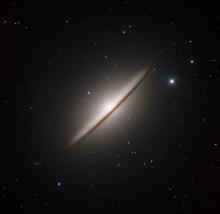Listen to today's episode of StarDate on the web the same day it airs in high-quality streaming audio without any extra ads or announcements. Choose a $8 one-month pass, or listen every day for a year for just $30.
You are here
Black-Hole Feast
It’s not unusual to see a black hole feast on a passing star or gas cloud. But one black hole has managed to make the feast last for more than a decade — and it’s not over yet.
The black hole is known by a catalog name — XJ-1500 for short. It’s in a galaxy that’s almost two billion light-years away. The galaxy is much smaller than our home galaxy, the Milky Way. But it’s giving birth to stars at a much faster rate — and that could be one reason for the long meal.
The black hole is at the heart of the galaxy. It’s probably a million times as massive as the Sun — about a quarter the heft of the black hole at the center of the Milky Way.
In 2005, an orbiting X-ray telescope saw the galaxy flare up. Over the next few months, the X-rays got even brighter — about a hundred times brighter than before the flare-up. The outburst has faded since then, but the galaxy’s X-rays are still unusually strong.
An international team of astronomers interpreted the flare-up as the disruption of a star that passed close to the black hole, and was pulled apart by the black hole’s gravity. That created a stream of super-hot gas that spiraled closer to the black hole.
The star was probably about twice the mass of the Sun — an unusually large meal for a black hole. The odds of the black hole grabbing such a massive star might have been enhanced by the fact that its galaxy is giving birth to so many stars — providing the entree for a black-hole feast.
Script by Damond Benningfield





